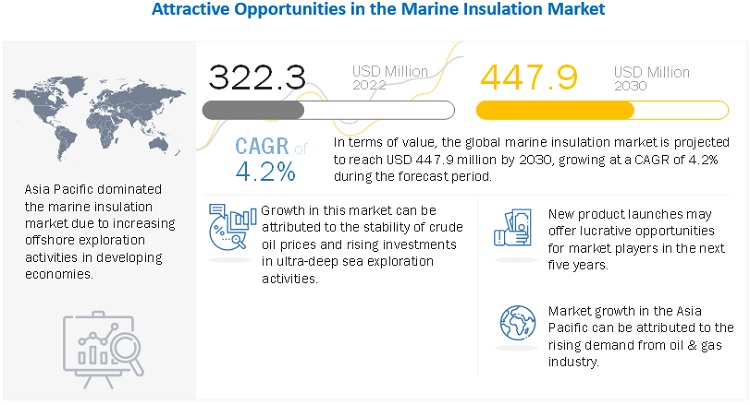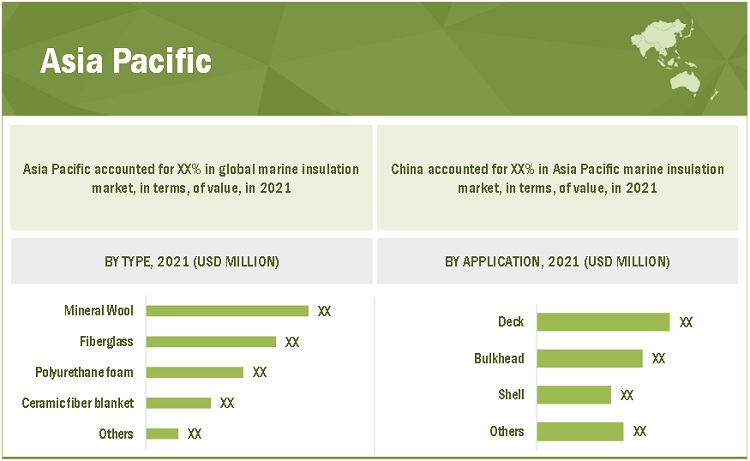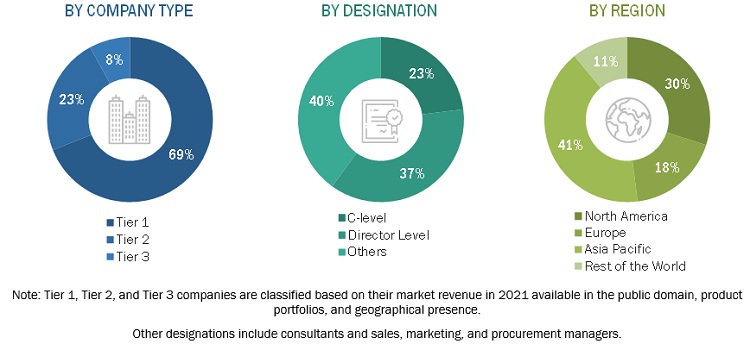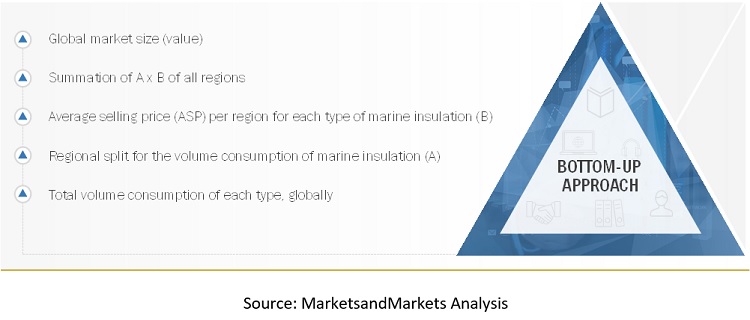Marine Insulation Market by Type (Mineral Wool, Fiberglass, Polyurethane foam, Ceramic Fiber Blanket), Application (Shell, Bulkhead, Deck, Others), and Region - Global Forecast to 2030
The marine insulation market is projected to reach USD 447.9 million by 2030, at a CAGR of 4.2% from USD 322.3 million in 2022. Marine insulation refers to the items or systems that are used to preserve and sustain the process conditions of deep-sea drilling and exploration equipment, joints, and pipes. Thermal insulation beneath the sea protects flow lines and equipment from corrosion, keeps the flow temperature constant, and keeps foreign particles out. The dynamics of offshore drilling activities across the world have a big impact on market demand for marine insulation. Furthermore, as ultra-deep water drilling activities increase, the demand for insulation products that can endure the extreme conditions found at deeper horizons is projected to drive the market for marine insulation.

To know about the assumptions considered for the study, Request for Free Sample Report
Market Dynamics
Driver: The regained stability of crude oil prices to drive the market
The regained stability of crude oil prices after a recent plunge, rising investments in ultra-deep sea exploration activities, and increasing awareness among explorers to optimize the process to reduce exploration costs are some of the factors driving demand for subsea thermal insulation.
Restraints: Low awareness regarding the usage of insulation products
Insulation materials are simple yet significant requirement in any industry dealing with various heat transfer operations. Proper use of insulation materials results in reducing heat loss and, in turn, cost savings. A lack of awareness about the benefits of proper insulation is a major restraint for the market.
Opportunities: New and innovative materials providing high-quality insulation capabilities can drive the growth of market
New variants of marine insulation materials such as fiberglass-based insulation materials, polyurethane-based materials, and aluminum-based insulation materials have all been introduced. These new and innovative materials provide high-quality insulation capabilities while also improving weight performance, which is predicted to provide a boost to the market.
“Mineral wool was the largest type of marine insulation market in 2021, in terms of value”
Mineral wool can be considered as an inorganic insulating material. It contains an average of about 75% post-industrial recycled materials and does not require additional chemicals to be fire-resistant. Mineral wool is naturally moisture-resistant and retains its insulating qualities even when wet. Mineral wool is also effective in blocking sound more efficiently, so the interior of a building suffers less acoustic invasion.
“Deck was the largest application for marine insulation market in 2021, in terms of value”
The insulation of a roof is just as important as the outer material. Insulation material is important to the longevity of your deck system and has been used since ages. Over the years, insulation has changed and adapted, but its purpose is the same; keeping heat inside when you need it and outside when you don’t.
“Asia Pacific was the largest market for Marine insulation in 2021, in terms of value.”
Asia Pacific accounted for the largest market share in the global subsea thermal insulation market in 2021 as a result of increasing offshore exploration activities in developing economies such as India, China, and Southeast Asian countries such as Vietnam, Malaysia, and Indonesia.

To know about the assumptions considered for the study, download the pdf brochure
Key Market Players
The key players in this market are Rockwool A/S (Denmark), Lindner AG (Germany), Knauf Gips KG (Germany), Johns Manville (US), Kingwell World Industries, Inc. (US), Syneffex (US), Owens Corning (US), Unifrax (US), Acoustafoam Limited (UK), Promat (Belgium) . Continuous developments in the market—including new product launches, mergers & acquisitions, agreements, and expansions—are expected to help the market grow. Leading manufacturers of marine insulation have opted for new product launches to sustain their market position.

Want to explore hidden markets that can drive new revenue in Marine Insulation Market?
 Scope of the Report
Scope of the Report

Want to explore hidden markets that can drive new revenue in Marine Insulation Market?

|
Report Metric |
Details |
|
Years considered for the study |
2017-2030 |
|
Base Year |
2021 |
|
Forecast period |
2022–2030 |
|
Units considered |
Volume (Kiloton); Value (USD Million) |
|
Segments |
Type, Application, and Region |
|
Regions |
Asia Pacific, North America, Europe, Middle East & Africa, and South America |
|
Companies |
Rockwool A/S (Denmark), Lindner AG (Germany), Knauf Gips KG (Germany), Johns Manville (US), Kingwell World Industries, Inc. (US), Syneffex (US), Owens Corning (US), Unifrax (US), Acoustafoam Limited (UK), Promat (Belgium) |
This report categorizes the global marine insulation market based on type, application, and region.
On the basis of type, the marine insulation market has been segmented as follows:
- Mineral Wool
- Fiberglass
- Polyurethane foam
- Ceramic Fiber Blanket
- Others
On the basis of application, the marine insulation market has been segmented as follows:
- Mineral Wool
- Fiberglass
- Polyurethane foam
- Ceramic Fiber Blanket
- Others
On the basis of region, the marine insulation market has been segmented as follows:
- Asia Pacific
- Europe
- North America
- Middle East & Africa
- South America
Frequently Asked Questions (FAQ):
What is the expected growth rate of marine insulation market?
The marine insulation market is projected to reach USD 447.9 million by 2030, at a CAGR of 4.2% from USD 322.3 million in 2022.
Who are the major key players in marine insulation market?
Rockwool A/S (Denmark), Lindner AG (Germany), Knauf Gips KG (Germany), Johns Manville (US), Kingwell World Industries, Inc. (US), Syneffex (US), Owens Corning (US), Unifrax (US), Acoustafoam Limited (UK), Promat (Belgium)
What is the average selling price trend for marine insulation market?
Prices are low in Asian countries (primarily China and India) compared to those in Europe and North America due to the low prices of raw materials and the availability of low-cost workforces in Asia Pacific. .
To speak to our analyst for a discussion on the above findings, click Speak to Analyst

Table of content
1 Introduction
1.1 Objective of the study
1.2 Market definition
1.3 Market Scope
1.3.1 Years considered for the study
1.4 Currency
1.5 Unit Considered
1.6 Stakeholders
2 Research Methodology
2.1 Research Data
2.2 Secondary Data
2.2.1 Key data from secondary sources
2.3 Primary Data
2.3.1 Key data from primary sources
2.3.2 Breakdown of Primary Interviews
2.4 Market Size Estimation
2.4.1 Bottom-Up Approach
2.4.2 Top-Down Approach
2.5 Data Triangulation
2.6 Assumptions
2.7 Limitations
3 Executive Summary
4 Premium Insights
4.1 Opportunities in Marine insulation Market
4.2 Marine insulation Market, By Type
4.3 Marine insulation Market, By Application
4.4 Marine insulation Market, By Region
5 Market Overview and Industry Trends
5.1 Introduction
5.2 Market Dynamics
5.2.1 Drivers
5.2.2 Restraints
5.2.3 Opportunities
5.2.4 Challenges
5.3 Supply Chain Analysis
5.3.1 Raw Material
5.3.2 Manufacturers
5.3.3 Distribution
5.3.4 End-Use Industry
5.4 Porter’s Five Forces Analysis
5.4.1 Threat of New Entrants
5.4.2 Threat of Substitutes
5.4.3 Bargaining Power of Buyers
5.4.4 Bargaining Power of Suppliers
5.4.5 Intensity of Competitive Rivalry
5.5 Average Selling Price
5.6 Regulatory Landscape
5.7 Industry Outlook
6 Marine insulation Market, By Type
6.1 Introduction
6.2 Mineral Wool
6.3 Fiberglass
6.4 Polyurethane foam
6.5 Ceramic Fiber Blanket
6.6 Others
7 Marine insulation Market, By Application
7.1 Introduction
7.2 Shell
7.3 Bulkhead
7.4 Deck
7.5 Others
8 Marine insulation Market, By Region
8.1 Introduction
8.2 Asia Pacific
8.2.1 China
8.2.2 India
8.2.3 Japan
8.2.4 South Korea
8.2.5 Indonesia
8.2.6 Rest of Asia Pacific
8.3 North America
8.3.1 U.S.
8.3.2 Canada
8.3.3 Mexico
8.4 Europe
8.4.1 Germany
8.4.2 France
8.4.3 Italy
8.4.4 U.K.
8.4.5 Spain
8.4.6 Russia
8.4.7 Poland
8.4.8 Rest of Europe
8.5 Middle East & Africa
8.5.1 UAE
8.5.2 Saudi Arabia
8.5.3 South Africa
8.5.4 Rest of Middle East & Africa
8.6 South America
8.6.1 Brazil
8.6.2 Argentina
8.6.3 Rest of South America
9 Competitive Landscape
9.1 Introduction
9.2 Market Share Analysis
9.3 Company Evaluation Quadrant
9.4 Competitive Situation & Trends
9.4.1 New Product Launches
9.4.2 Contracts & Agreements
9.4.3 Partnerships & Collaborations
9.4.4 Joint Ventures
9.4.5 Expansions
10 Company Profile
10.1 Rockwool A/S
10.1.1 Business Overview
10.1.2 Products Offered
10.1.3 Recent Development
10.1.4 MnM View
10.1.4.1 Key Strengths
10.1.4.2 Strategic choices made
10.1.4.3 Threat from competition
10.2 Lindner AG
10.3 Knauf Gips KG
10.4 Johns Manville
10.5 Kingwell World Industries, Inc.
10.6 Syneffex
10.7 Owens Corning
10.8 Unifrax
10.9 Acoustafoam Limited
10.1 Promat
10.11 List of other key market players
11 Appendix
11.1 Insights from Industry Experts
11.2 Discussion Guide
11.3 Related Reports
The study involved four major activities to estimate the size of marine insulation market. Exhaustive secondary research was done to collect information on the market, the peer market, and the parent market. The next step was to validate these findings, assumptions, and sizing with industry experts across the value chain through primary research. Both top-down and bottom-up approaches were employed to estimate the complete market size. Thereafter, the market breakdown and data triangulation procedures were used to estimate the market size of the segments and subsegments.
Secondary Research
In the secondary research process, various secondary sources have been referred to for identifying and collecting information for this study. These secondary sources include annual reports, press releases, investor presentations of companies, white papers, certified publications, trade directories, certified publications, articles from recognized authors, gold standard and silver standard websites, and databases.
Secondary research has been used to obtain key information about the value chain of the industry, monetary chain of the market, the total pool of key players, market classification and segmentation according to industry trends to the bottom-most level, and regional markets. It was also used to obtain information about the key developments from a market-oriented perspective.
Primary Research
The marine insulation market comprises several stakeholders in the value chain, which include raw material suppliers, manufacturers, distributors, and end users. Various primary sources from the supply and demand sides of the marine insulation market have been interviewed to obtain qualitative and quantitative information.
The primary interviewees from the demand side include key opinion leaders in end-use sectors. The primary sources from the supply side include manufacturers, associations, and institutions involved in the marine insulation industry.
The breakdown of profiles of the primary interviewees is illustrated in the figure below:

To know about the assumptions considered for the study, download the pdf brochure
Market Size Estimation
The top-down and bottom-up approaches have been used to estimate and validate the size of the marine insulation market.
- The key players in the industry have been identified through extensive secondary research.
- The supply chain of the industry has been determined through primary and secondary research.
- All percentage shares, splits, and breakdowns have been determined using secondary sources and verified through primary sources.
- All possible parameters that affect the markets covered in this research study have been accounted for, viewed in extensive detail, verified through primary research, and analyzed to obtain the final quantitative and qualitative data.
- The research includes the study of reports, reviews, and newsletters of the key market players, along with extensive interviews for opinions with leaders such as directors and marketing executives.
Marine Insulation Market: Bottom-Up Approach 1

To know about the assumptions considered for the study, Request for Free Sample Report
Data Triangulation
After arriving at the total market size from the estimation process explained above, the overall market has been split into several segments and sub-segments. To complete the overall market engineering process and arrive at the exact statistics for all the segments and sub-segments, the data triangulation and market breakdown procedures have been employed, wherever applicable. The data has been triangulated by studying various factors and trends from both the demand and supply sides. Along with this, the market size has been validated by using both the top-down and bottom-up approaches and primary interviews. Hence, for every data segment, there have been three sources—top-down approach, bottom-up approach, and expert interviews. The data was assumed correct when the values arrived from the three sources matched.
Report Objectives
- To define, describe, and forecast the size of the marine insulation market, in terms of value and volume
- To provide detailed information regarding the major factors (drivers, opportunities, restraints, and challenges) influencing the growth of the market
- To estimate and forecast the market size based on type and application
- To forecast the size of the market with respect to major regions, namely, Europe, North America, Asia Pacific, and Middle East & Africa, and South America along with their key countries
- To strategically analyze micromarkets1 with respect to individual growth trends, prospects, and their contribution to the overall market
- To analyze opportunities in the market for stakeholders and provide a competitive landscape of market leaders
- To track and analyze recent developments such as expansions, new product launches, partnerships & agreements, and acquisitions in the market
- To strategically profile key market players and comprehensively analyze their core competencies2
Available Customizations
Along with the given market data, MarketsandMarkets offers customizations according to the company’s specific needs. The following customization options are available for the report:
- Regional Analysis
Further breakdown of a region with respect to a particular country or additional application
- Company Information
Detailed analysis and profiles of additional market players














Growth opportunities and latent adjacency in Marine Insulation Market